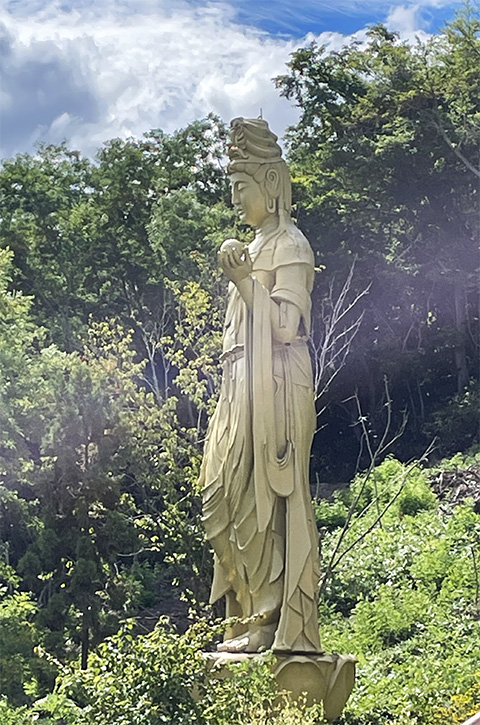
写真は先日参詣していた菩提寺の境内に立っていた菩薩像。名前とか由縁などは確認してはいない。たまたま写真に収めてあとでパソコン画面で確認したら、なんとうっすらと霧が立ちこめていたのが、写真に写り込んでいた。なんとも神々しい雰囲気。菩提寺は後背に山を背負っていて、一度も行っていないのだけれど88箇所の参拝ポイントがあるのだと聞いている。そういう山の「気」が映り込んでくれたのかも知れないと喜んでいる。
ご多分に漏れず、加齢とともに「心的風景」のようなことにこころが自然に向かっていく。健康のこととか寿命のこととかに否が応でも向き合うようになって、ひととして自然なことなのでしょう。
日本列島では四季の変化が非常に明瞭だけれど、その四季変化がながく日本列島人に「花鳥風月」という心性を日本人らしさの骨格にしてきたと思う。とくに北海道という寒冷地も日本人の自然環境観に加わってきたことで、より深い陰影感が加わった。
先日観てきた後藤純男さんの日本画には、そのあたりの日本人の「花鳥風月感」が大きく拡大・拡張した様子が、心象風景として表現されているように思えてならない。日本画という表現形式自体、日本人的な「自然」観をわかりやすく伝えてくれている。
「こういう景色を見て、やっぱりこういう表現に至るよなぁ」という日本人的な納得感、美感というようなものがつたわってくるのだと思う。そしてそういう表現の系譜、連綿と伝わってきた精神性に深く帰依したくなってくるのだと思う。
もののあわれ、という日本人的心性のコアと思える領域が、花鳥風月と通底する世界観。四季変化の中で諸行無常という哲学も自然に日本人は獲得してきたのでしょう。縄文社会由来の生活様式伝統のなかで明瞭な四季変化はその骨格を形成してきた。たぶん八百万の神が祀られる神道の世界観のベースなのだろう。それに対して世界宗教である仏教が伝来してくるけれど、他国の場合とは違って、日本列島では両者が非対立的に、基層と表層のように機能してきたのではないか。ホンネと建前みたいな「落とし所」感覚が日本人に強く生起していったと思える。世界宗教である仏教寺院である高山寺の宝物として「鳥獣戯画」のようなマンガ表現が存続し続けてきた社会。
おっと、お盆休暇はきのうまでだった(笑)。これは休暇の「総括」か。
本日から、残っていた懸案を処理して、またあらたな役務がスタートであります。なんとかテキパキと処理して行きたいと思います。
English version⬇
The mental image of “Kacho Fugetsu” and the way of dealing with religion
As I age, I am drawn more and more to the “mercy of things” sentiment. The four seasons show us their diverse expressions from year to year. The Obon vacation is over, and I’m back on track. … .
The photo shows a statue of a bodhisattva standing in the precincts of a family temple where I was paying a visit the other day. I did not confirm the name or the origin of the statue. I happened to take a picture of it, and when I checked it on my computer screen later, to my surprise, a faint mist was rising in the air, which appeared in the picture. It was a divine atmosphere. The Bodai-ji temple is backed by a mountain, and although I have never been there, I have heard that there are 88 places of worship. I am happy that the “spirit” of the mountain may have been reflected in the image.
As is typical, as one ages, one’s mind naturally turns to things like “mental landscapes. We are forced to face our health and life expectancy, and this is a natural part of human nature.
The Japanese archipelago has four distinct seasons, and I believe that this seasonal change has long been the backbone of the “Kacho Fugetsu” (flower, bird, wind, and moon) mentality of the Japanese people. In particular, the cold climate of Hokkaido has added a deeper sense of shade to the Japanese view of the natural environment.
The Japanese-style paintings of Sumio Goto that I saw the other day seem to me to express, as mental landscapes, the expansion and extension of the Japanese people’s sense of “Kacho Fugetsu” (flowers, birds, winds, and the moon). The form of expression itself, Japanese-style painting, conveys the Japanese view of “nature” in an easy-to-understand manner.
The Japanese view of “nature” is conveyed in a way that is easy to understand. I believe that the Japanese people are deeply moved by the lineage of such expressions and the spirituality that has been handed down from generation to generation.
Mono no aware (mercy of things), a core area of Japanese spirituality, is a worldview that is commonly shared by Kacho Fugetsu (flowers, birds, winds, and the moon). The Japanese have naturally acquired the philosophy of the impermanence of all things through the changes of the four seasons. The distinct changes of the four seasons have formed the framework of the lifestyle traditions of the Jomon society. This is probably the basis of the Shinto worldview, in which 8 million deities are worshipped. In contrast, Buddhism, a world religion, was introduced to Japan, but unlike in other countries, in the Japanese archipelago the two have functioned in a non-confrontational manner, as if they were the base and the surface of the world. It seems to me that a sense of “the bottom line,” like “honne” and “tatemae,” has emerged strongly in the Japanese people. In a society where cartoon expressions such as “Birds and Beasts Caricatures” have continued to exist as treasures of Kozan-ji Temple, a Buddhist temple that is a world religion.
Oops, my Bon vacation ended yesterday (laugh). This is the “summary” of the vacation.
Today, I will start my new duties again, dealing with the remaining issues. I will try to handle it as quickly and efficiently as possible.
Posted on 8月 19th, 2024 by 三木 奎吾
Filed under: 日本社会・文化研究







コメントを投稿
「※誹謗中傷や、悪意のある書き込み、営利目的などのコメントを防ぐために、投稿された全てのコメントは一時的に保留されますのでご了承ください。」
You must be logged in to post a comment.